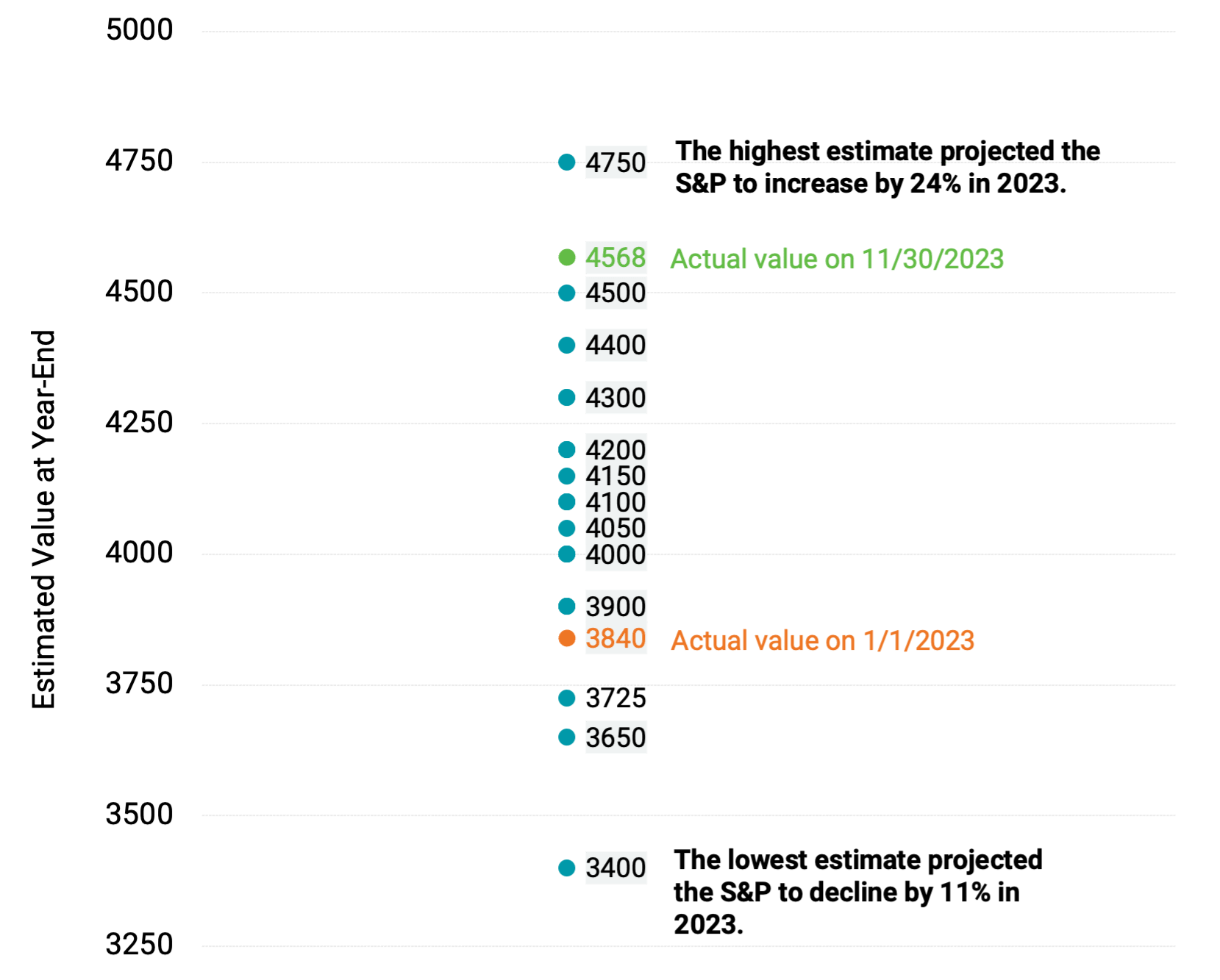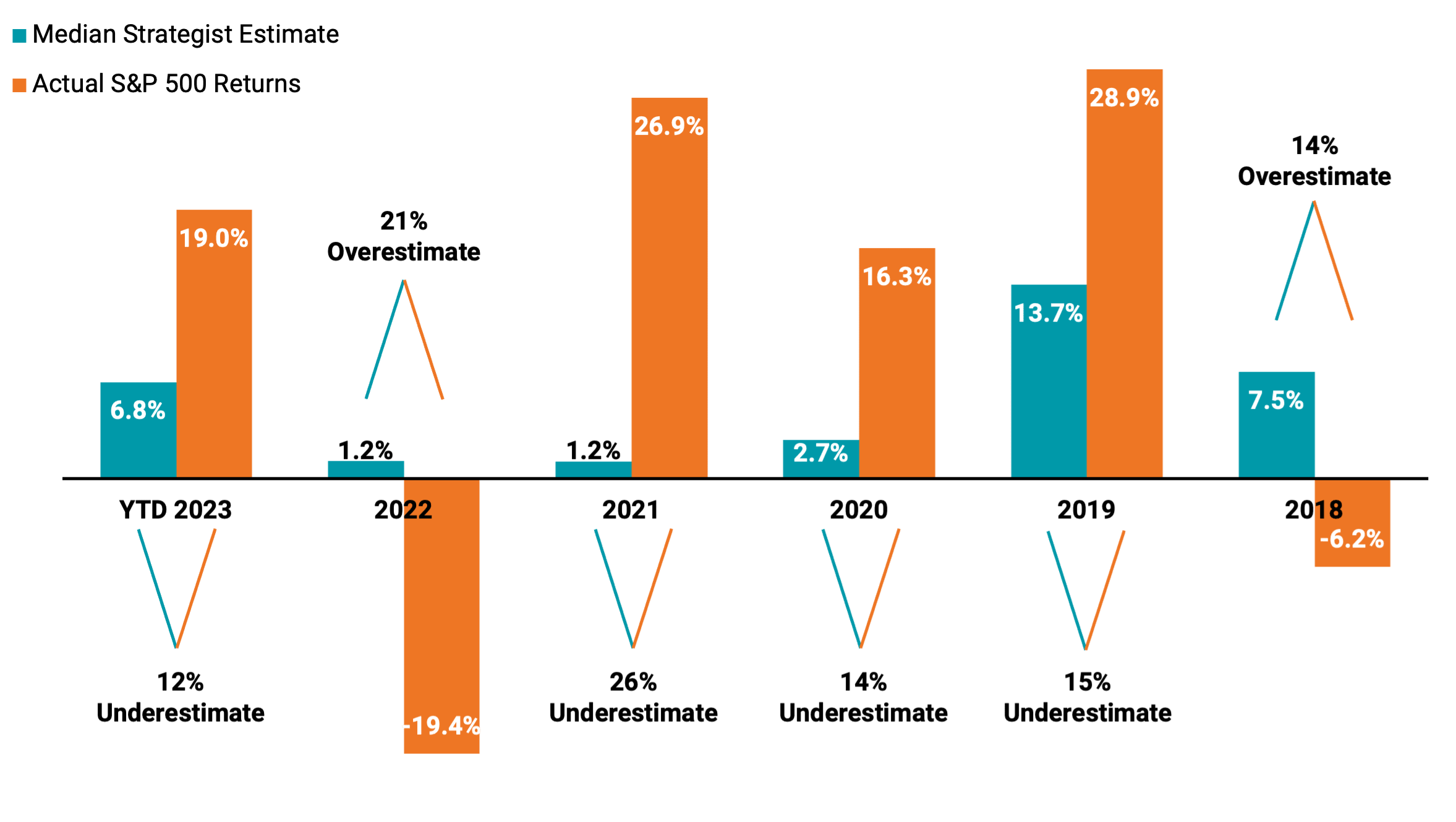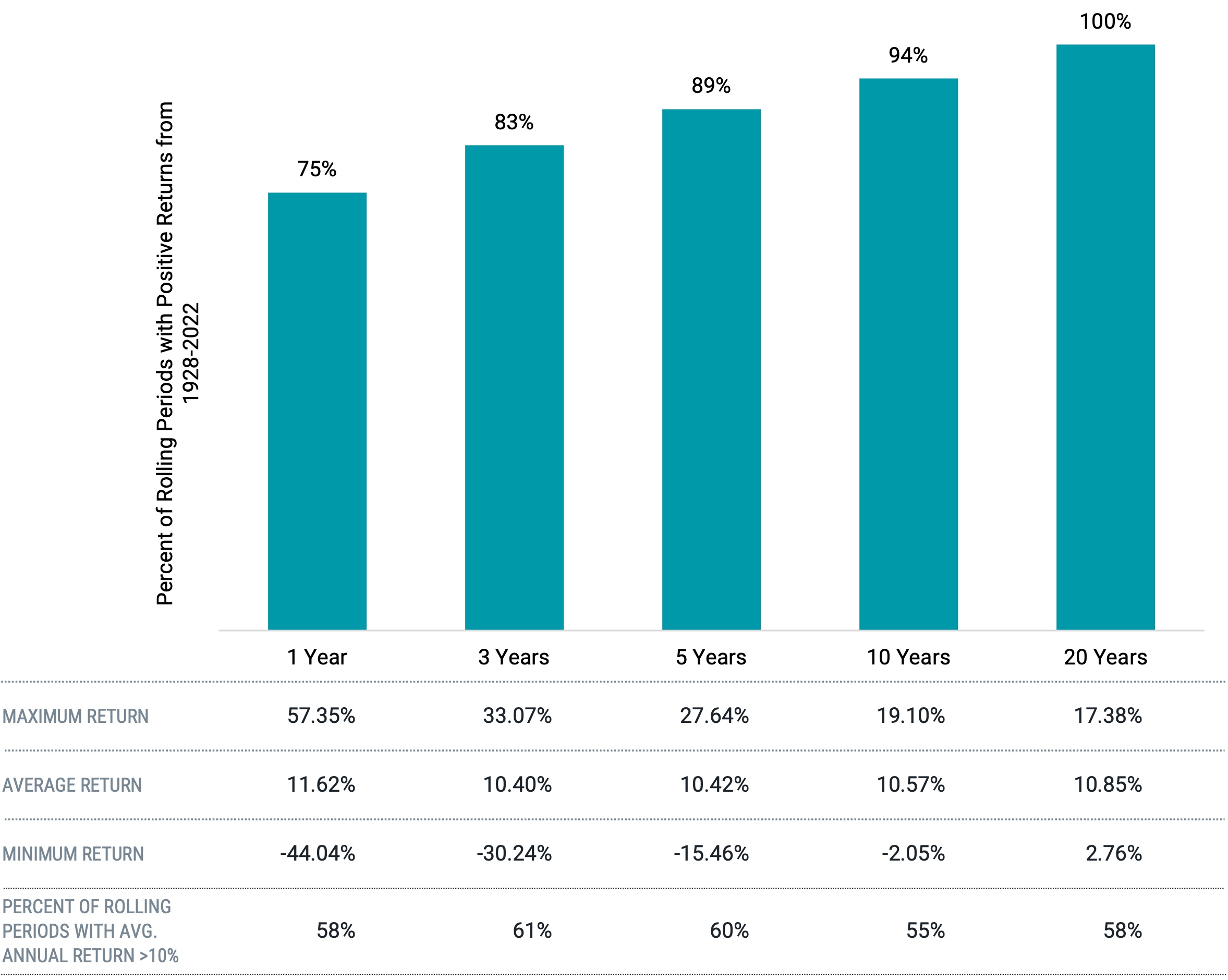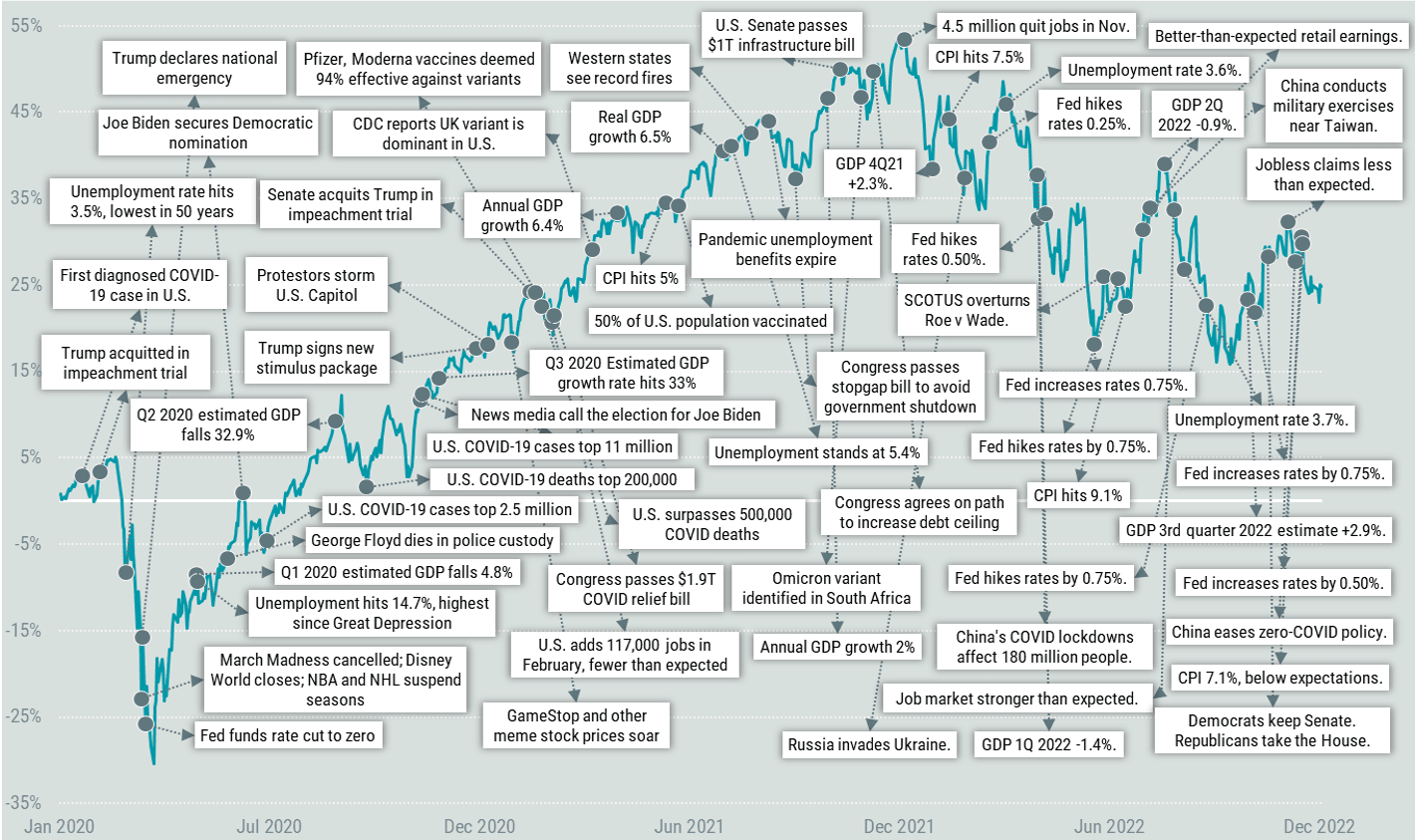Taking a Holistic View of Your Investment Journey
It’s that time of year again. Cooler weather is upon us. Colorful lights are starting to pop up on rooftops. The kids are excited as they count down the remaining days of their fall semester.
You guessed it. It’s market forecasting season.
Every year around this time, we begin to see “expert” forecasts on where the market will go next year. Many investors rely on these predictions to inform their portfolio positioning.
The problem? No one is very good at consistently getting these forecasts right.
We looked back at past estimates from industry strategists to offer some perspective. First, there tends to be a wide range of projected outcomes across strategists.
Figure 1 provides an example that plots 23 firms’ estimates of the S&P 500® Index level at the end of 2023.
Figure 1 | Performance Estimates for the S&P 500 in 2023 Varied Widely

Data as of 11/30/2023. Source: Senad Karaahmetovic, “Top Wall Street Strategists Give Their S&P 500 Forecasts for 2023,” Investing.com, December 27, 2022. Number of forecasted levels in the chart is less than total firms represented due to duplicate forecasts.
In Figure 2, we show median, or consensus, estimates from compiled industry strategist forecasts versus actual S&P 500 returns for year-to-date 2023 and the preceding five years. The results fall short of inspiring awe. For the five completed years, the estimation error ranged from 26% too low to 21% too high. On average, the median annual estimate was off by about 18 percentage points — nearly double the index’s long-term average annual return!
Figure 2 | Consensus S&P 500 Estimates vs. Actual Returns (2018-2023)

Data from 1/1/2018 - 11/30/2023. Sources: Emily McCormick, “What Wall Street Strategists Forecast for the S&P 500 in 2019,” Yahoo Finance, December 31, 2018; Jeff Sommer, “Clueless About 2020, Wall Street Forecasters Are at It Again for 2021,” New York Times, December 18, 2020; Jeff Sommer, “Forget Stock Predictions for Next Year. Focus on the Next Decade,” New York Times, December 16, 2022; Senad Karaahmetovic, “Top Wall Street Strategists Give Their S&P 500 Forecasts for 2023,” Investing.com, December 27, 2022. Past performance is no guarantee of future results.
Academic research offers more insight into the difficulties of predicting the annual equity premium. In 2008, finance professors Ivo Welch and Amit Goyal published a study on the performance of predictive equity premium models.
They explored 17 variables previously published in papers as good predictors of the equity premium. They found that when examined out of the sample, most models failed to deliver statistically significant outperformance versus the long-term average equity return in predicting future equity premiums.
Many underperformed the long-term average entirely. In 2021, they updated their work, including 29 additional variables, with no change to the key takeaway of their original findings.1
The implications for predicting next year’s S&P 500 return are clear but also offer a note of caution for the long-term capital market assumptions (e.g., 10- or 20-year estimates) that strategists often put out. It’s worth pointing out that there’s wide variation in those estimates when comparing them across firms, so investors should bear in mind that using them could yield meaningfully different results.2
But what does it mean to use long-term averages as our base expectation for the future? What we know is that stocks have positive expected returns, which are higher than what we should expect to achieve with bonds. But we also must recognize that they have higher variability over time.
The long-term average returns and volatility (standard deviation) for stocks and various bond categories are presented in Figure 3.
Figure 3 | Long-Term Average Returns and Volatility Across Asset Classes

Data from 1928 - 2022. Sources: U.S. Stocks are sourced from Ken French’s Data Library. Bond returns are sourced from the New York University Stern School of Business. Past performance is no guarantee of future results.
To put it in perspective, consider this analogy for the probability of stock returns. Imagine a non-translucent bag with 12 green balls and 8 red balls. Despite having a higher likelihood of picking a green ball than a red one, there is plenty of uncertainty about any individual draw.
While the odds are higher of having 2, 3, 4 (or more) consecutive green draws, we can be unlucky and get 2, 3, 4 (or more) consecutive red draws. But that doesn’t change the odds in favor of green for the next draw. We know that if we look at a collection of many draws, greens will win about 60% of the time.
Figure 4 digs deeper into historical U.S. stock returns. Relating to our green and red ball analogy, holding stocks for longer periods has historically resulted in a greater chance of realizing a positive return (shown in the bar chart below).
The table also shows the percentage of periods that have resulted in returns (annualized for periods greater than one year) that have exceeded 10% — a common heuristic for the average annual return for stocks. The outcome is about 60% regardless of the time horizon, but importantly, the range of outcomes narrows with longer periods, as shown in the max and min return observations.
Figure 4 | The Probability of Positive U.S. Equity Returns Increases with Time

Data based on annual U.S. stock returns from 1928-2022. U.S. Stocks are represented by the Market Portfolio from Ken French’s Data Library. Return periods greater than one year are annualized. Rolling return analysis includes 95 1-year periods, 93 3-year periods, 91 5-year periods, 86 10-year periods, and 76 20-year periods. Past performance is no guarantee of future results.
Predicting intentionally (i.e., due to overconfidence) or unintentionally (i.e., due to fear) what will happen the next day, week, month or year with the stock market steers us from looking at our investment journey as a whole.
Making market calls based on short-term predictions with no predictive power can potentially leave us worse off versus focusing on expectations based on the rich history of empirical data. The research from Welch and Goyal highlights this point.
Remember, previously unexpected news and uncertainty will push markets up and down, as shown in Figure 5 for the last three years of the S&P 500 alongside notable headlines. Recognizing that this is a reality of investing but focusing on the big picture can help us avoid the temptation and pitfalls of trying to forecast markets.
Figure 5 | As Much of 2020-2022 That Fits on One Page

Data from 1/1/2020 - 12/31/2022. Source: FactSet, Avantis Investors.
Watch for our 2023 headlines chart after market close on December 29!
Glossary
Consumer Price Index (CPI): CPI is the most commonly used statistic to measure inflation in the U.S. economy. Sometimes referred to as headline CPI, it reflects price changes from the consumer's perspective. It's a U.S. government (Bureau of Labor Statistics) index derived from detailed consumer spending information. Changes in CPI measure price changes in a market basket of consumer goods and services such as gas, food, clothing, and cars. Core CPI excludes food and energy prices, which tend to be volatile.
Federal Reserve (Fed): The Fed is the U.S. central bank, responsible for monetary policies affecting the U.S. financial system and the economy.
Gross Domestic Product (GDP): A measure of the total economic output in goods and services for an economy.
Real Gross Domestic Product: An inflation-adjusted measure that reflects the value of all goods and services produced by an economy in a given year.
S&P 500 Index: A market-capitalization-weighted index of the 500 largest U.S. publicly traded companies. The index is widely regarded as the best gauge of large-cap U.S. equities.
Standard deviation: A statistical measurement of variations from the average. In financial literature, it's often used to measure risk, when risk is measured or defined in terms of volatility. In general, more risk means more volatility and more volatility means a higher standard deviation — there's more variation from the average of the data being measured.
U.S. Treasury securities: Debt securities issued by the U.S. Treasury and backed by the direct "full faith and credit" pledge of the U.S. government. Treasury securities include bills (maturing in one year or less), notes (maturing in two to 10 years) and bonds (maturing in more than 10 years). They are generally considered among the highest quality and most liquid securities in the world.
Endnotes
1 Ivo Welch and Amit Goyal, “A Comprehensive Look at the Empirical Performance of Equity Premium Prediction,” Review of Financial Studies 21, no. 4 (July 2008): 1455-1508; Amit Goyal, Ivo Welch, and Athanasse Zafirov, “A Comprehensive 2022 Look at the Empirical Performance of Equity Premium Prediction,” Swiss Finance Institute Research Paper No. 21-85 (September 2021).
2 Horizon Actuarial Services, “Survey of Capital Market Assumptions 2023 Edition,” August 2023.
Investment return and principal value of security investments will fluctuate. The value at the time of redemption may be more or less than the original cost. Past performance is no guarantee of future results.
This material has been prepared for educational purposes only. It is not intended to provide, and should not be relied upon for, investment, accounting, legal or tax advice.
The opinions expressed are those of the portfolio team and are no guarantee of the future performance of any Avantis fund.
The letter ratings indicate the credit worthiness of the underlying bonds in the portfolio and generally range from AAA (highest) to D (lowest).